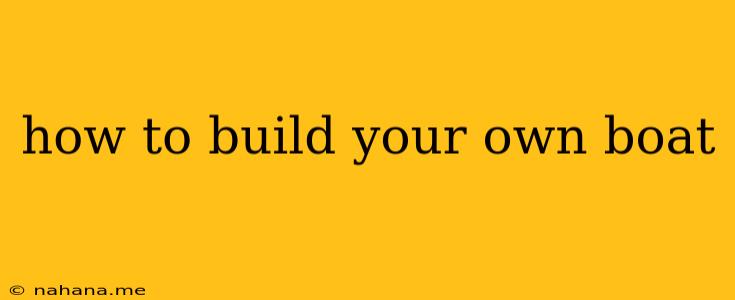Building your own boat can be a rewarding and challenging project. It requires time, patience, and a good set of skills, but the satisfaction of seeing your creation come to life is unmatched. Here's a step-by-step guide to help you embark on this exciting journey.
1. Choosing Your Boat Design
The first step is to choose the type of boat you want to build. Consider factors such as:
- Size: How many people will you be taking out on the water?
- Type: Do you want a rowboat, a sailboat, a motorboat, or a kayak?
- Purpose: Will you be using it for fishing, cruising, racing, or something else?
Once you have a general idea, start researching different boat designs. There are countless resources available online and in libraries. You can also consult with experienced boat builders for advice.
2. Gathering Materials and Tools
After you've chosen your design, you'll need to gather the necessary materials and tools. This will depend on the type of boat you're building. Here are some common materials:
- Wood: Plywood, cedar, mahogany, and other marine-grade woods are popular choices.
- Fiberglass: This is often used to reinforce and waterproof wooden hulls.
- Epoxy resin: This is a strong adhesive that bonds wood and fiberglass together.
- Hardware: This includes things like screws, bolts, cleats, and other fittings.
You'll also need a variety of tools, including:
- Power saw: For cutting wood
- Sanding tools: For smoothing surfaces
- Drill: For drilling holes and attaching hardware
- Measuring tools: For ensuring accurate measurements
- Safety gear: This includes eye protection, gloves, and dust masks.
3. Building the Hull
The hull is the main structure of the boat. It's often constructed using a combination of wood and fiberglass. The process may involve:
- Creating a mold: This is a temporary form that you'll use to shape the hull.
- Laying up the wood: You'll carefully cut and assemble the wood pieces to create the hull shape.
- Applying fiberglass: Fiberglass is used to reinforce and waterproof the hull.
- Sanding and finishing: Once the fiberglass has cured, you'll need to sand the hull smooth and apply a protective finish.
4. Installing the Deck and Interior
Once the hull is complete, you can begin working on the deck and interior. This may involve:
- Building frames: These will support the deck and other interior components.
- Installing bulkheads: These are walls that divide different compartments of the boat.
- Installing seating: This could include benches, chairs, or even a cockpit.
- Adding storage: You may want to install shelves, compartments, or lockers to store equipment.
5. Installing the Power System
If you're building a motorboat, you'll need to install the engine and its associated components. This includes:
- Installing the motor: This will require a mounting plate and brackets.
- Connecting the fuel system: You'll need to install fuel lines, a fuel tank, and a fuel pump.
- Installing the electrical system: This includes the battery, wiring, and electrical controls.
- Installing the steering system: This will allow you to control the direction of the boat.
6. Launching and Testing
Once your boat is complete, it's time to launch it and test it out. Before launching, be sure to:
- Inspect the boat: Look for any loose connections, leaks, or other potential problems.
- Check the weather: Make sure the conditions are safe for launching.
- Have a safety plan: Ensure you have life jackets and other safety equipment onboard.
7. Enjoy Your Boat!
Congratulations! You have successfully built your own boat. Now it's time to enjoy your hard work and all the adventures it brings. Remember to always practice safe boating and follow all local regulations.
